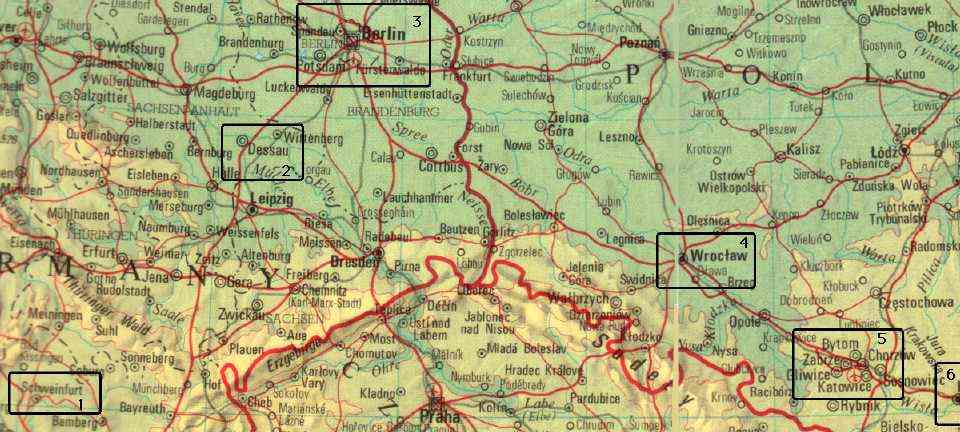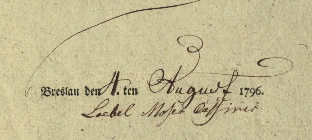

Note: In the map above numbers refer to the following places: 1. Schweinfurt 2. Dessau 3. Berlin, 4 Breslau (now Wroclaw), 5 Schwientochlowitz, 6. Krakau (Cracow in English) - click on map to expand it.
The first was Moses ben Israel Lazarus (Isserles-Lazarus) He was born between 1523-30 and would, in modern language, have been known as Rabbi Moses Isserles.† He died near the age of 50 in 1572 in Cracow, in Poland. He was an imposing man and he founded a Yeshiva and was its Rosh Jeshivah (President) for life. He was the author of "Darkhe Moshe" the ashkenazi viewpoint of Josef Caro's sephardic Halachic tradition. He was the codifier of ashkenazi traditions and through his additions, the "Shulchan Aruch" became the authoritative work among the Ashkenazim. This family tree descends from Moses in a line to join with the son of the first identified Cassirer, Loebel Moses Cassirer 1738-1880 and his wife Sarah (Zerchen) Ruben 1743-1809. Loebel's Stamm Nummer, a form of residence permit survives. It shows he had not quite as many rights as 'General Privileg', but better than 'Toleriert' and that he was a also a steuernumerant (number holder) and thus was a tax paying member of the community. (For a note on the origin of the Cassirer name click here.) Loebel's signature survives on his Stamm Nummer and this echo from 1796 is shown below.

Loebel and Sara had at least 4 sons including: Gerson (born 1768), Hirsch (born 1772), Jacob (born 1774) and Moses (born 1771) ben Loebel Cassirer. The latter, Moses Loebel Cassirer (1771-1837) as he later came to be called, married Pesel Bat Salomon Friedlander (GGGGGG Granddaughter of Moses ben Israel Lazarus- see above) in 1791. And it is from this union that that the line of Cassirers whose history is recounted here are descended.
Amongst the children of Moses Cassirer and Pesel was Markus Cassirer , born in lower Silesia, in Schwientochlowitz (later the site of a Nazi death camp and now situated in Poland), in 1801. Markus Cassirer married Jeanette Steinitz . Their children who would map out a remarkable history. That history of the Cassirer descendants is expanded on in considerable detail here.
The second man of interest was Don Menachem Chajim Ha-Kohen. He was born in 1650 and is said to have come from Spain to Holland and then to Niederwerrn [Niderweren]. Niederwerrn is a small village outside Schweinfurt in the northern part of what is now the German state of Bavaria. (No Jews live in Niederweren anymore. The beautiful city of Schweinfurt is also now the home of the 12,000 soldiers of the US 1st Infantry Division - "The Big Red One". )
Don Menachem's grandchildren included Chajim born in 1761, Hannah (1766-1848), Levy (1775-1851) and Menachen Hayum Ha-Kohen (1762). As a result of legislation enforcing adoption of surnames, some branches of the family adopted the new name Kohnstamm, others dropped the prefix 'Ha' and became known as Kohn. (Cohn was at that time a legitimate alternative spelling.)
Menachen Hayum Ha-Kohen emigrated to England in 1782 and established a family in Brighton. It was in the course of this that he anglicized his name to "Emanuel Hyum Cohen". (Much later, the family he left behind in Germany took up the family name Kohnstamm.) All of Emanuel Cohen's descendants remaining in England are through the female line. But the name Cohen continues on born by the numerous progeny of his sons who emigrated from England. Emanuel Cohen's descendants spread across Canada, the USA, South Africa, New Zealand and Australia.
It was one of Emanuel Cohen's sons, Abraham Cohen, who arrived from England in Australia in 1835 . A year later he married Sophia, the daughter of Henry Cohen (a tailor who in 1833 had been transported from London to Australia for possessing several stolen promissory notes). And it was Barbara Cohen, GG Grandaughter of Henry Cohen, and also sister in law to Abraham Cohen's G Grandson Bruce Benjamin, who would meet, and ultimately marry a son of a Cassirer.
Abraham Cohen (1812-1874) |
Sophia Cohen (1816-1882) |
Henry Cohen (1790-1867) |
There is not much more that need be said here about this. Both stories begin not far apart close to what is now the border of Poland and Germany. This is not purely coincidence, since this was also a place where Jewish people could survive, at least for periods of this history without constant persecution [see note on the history of Central Europe]. Both families are forced apart, the Cassirers by the holocaust, and the Cohens first by an earlier period of persecution and then, in the case of Abraham Cohen, by the desire to find better financial circumstances through emigration. And as a result, the lines curve together to intersect some three hundred years later - about as far away as is possible - across the other side of the world in Australia.
Obviously how we see the world depends on where we stand in it. As one of the children of that union of a Cohen and son of a Cassirer, there is some interest in that intersection of what are otherwise separate and distant stories. But the broader interest will be in the two distinct Cohen and Cassirer stories and some highlights are provided in following pages.
Click here for Cassirers: Founding Years
Click here for Cohen: Beginnings in Australia
Of course Cohen and Cassirer are not the only families whose trajectories intersect at this point. Wives and husbands from other families merge in bringing other influences and histories. Over time, some of the other family histories which emerge as important influences will also be added to this overview. One is that of the Falk family, which originated in Dessau, also in the same area of Central Europe as the Cassirers and Cohens, and which became entwined with both.
Click here for Falk: Scattered from Dessau - across two hemispheres and four continents
[For sources and more detail about the Ha-Kohen history click here]